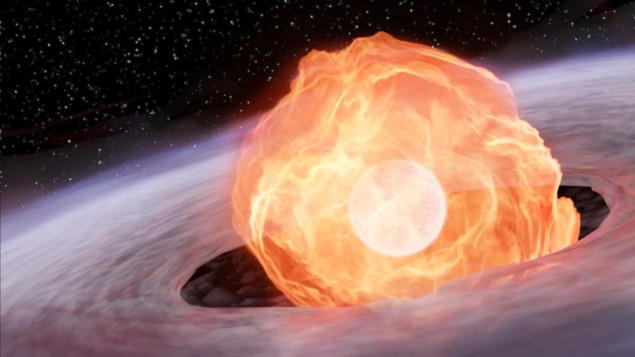Rare X-rays from white-dwarf explosion spotted by chance
30 May 2022

Astronomers have made the first observations of X-rays being emitted from a white-dwarf star that has burst into life while stripping material from a companion star. The process caused a thermonuclear runaway that resulted in a massive explosion or nova.
Ole König a PhD student at the Dr Karl Remeis-Observatory and Erlangen Centre for Astroparticle Physics at Friedrich-Alexander-University, Germany and colleagues used the eROSITA telescope to observe the tell-tale X-rays that signal the onset of the violent process. The X-rays were emitted by the white dwarf YZ Reticuli 11 h, which is located over 8800 light-years from Earth. Remarkably, the observation was made by chance – but previous research allowed the scientists to understand what they had seen.
“We were quite lucky that eROSITA was pointed to the right patch of the sky at the right moment,” König, lead author of a Nature paper describing the discovery, tells Physics World. “For over 30 years it has been postulated that novae should show X-ray flashes. These flashes are a direct consequence of the fusion process, a so-called thermonuclear runaway, that occurs on the surface of the white dwarf.”
Brief emission
König explains that X-rays from such an event should be emitted briefly, just before the white dwarf brightens with visible light. The spectral distribution of these X-rays is expected to resemble that of a black body. The team found that there was no X-ray source detected by eROSITA both four hours before and four hours after the event meaning the bright flash must have lasted less than six hours. This is in good agreement with theoretical models, and this told the team they had indeed spotted an X-ray flash from the nova explosion for the first time.
König explains why this kind of X-ray emission is only just being glimpsed for the first time. “It is very difficult to find such a source because there are only around 40 to 50 novae per year in our galaxy and most of them are from sources that are not known before they are seen in the optical wavelengths,” he says. “At this time the X-ray flash is, however, already over and this is the reason why it took so long to discover them.”
Despite fitting well with theoretical predictions, the astronomers’ fortuitous discovery still yielded some surprises. “The most surprising thing was that the source was so bright. Too bright actually,” König says. “It overexposed the central part of the detector because so many X-ray photons arrived in such a short time.”
This meant the researchers had to come up with a clever way to analyse the overexposed data , which was done using a simulator called SIXTE, designed specifically to study bright sources with eROSITA.
Kick-started fusion
White dwarfs are the remnants of stars like the Sun. These objects have burned all the hydrogen in their cores, but they do not have mass needed to kick-start the fusion of heavier elements like carbon and nitrogen. As a result, isolated white dwarfs spend the rest of their existence as a gradually cooling inert exposed core of mostly carbon.
However, white dwarfs can spring back into life, albeit briefly, when in a close-proximity binary system with a star that donates matter to the white dwarf. This material, mostly hydrogen, is stripped from the donor and accreted onto the white dwarf’s surface. As this happens immense pressure builds beneath this donated envelope of material. Because the gas is forced into a state in which quantum properties set the pressure, the accreted hydrogen cannot expand despite the temperature increasing.
As the temperature rises in this region, it triggers thermonuclear reactions. Fusion rates increase rapidly as the temperature builds and the reactions run out of control. The white dwarf then blows off much of the accreted layer —which is estimated to have a temperature of several million degrees — reliving the pressure and expanding its radius.
‘Fireball’ created
“The X-rays are emitted as a consequence of the thermonuclear runaway. The fusion process creates a lot of energy that diffuses through the envelope of mostly hydrogen,” König says. “When it reaches the top of the envelope the nova is a very hot glowing black body or a ‘fireball’.”READ MORE

“This black body emits radiation and it peaks in the soft X-rays. The explosion is a very, very dynamic situation. The envelope quickly expands and the temperature drops. Thus, the source becomes visible in the optical a few hours after the X-ray flash.”
The explosion that results is often called a “recurrent nova” because the white dwarf is left intact, unlike in “classic” supernova explosions, and can continue to accrete material from its donor star companion allowing the process to occur over again.
“There are certainly still questions left to answer about these novae. For example, how the X-ray flash decays or how fast the envelope expands,” König explains. “It would be great to go through the eROSITA dataset or propose another satellite with higher spatial resolution and sensitivity to find more of these flashes.”
Rob Lea is a science writer based in the UK.
from physicsworld.com 4/6/2022
Δεν υπάρχουν σχόλια:
Δημοσίευση σχολίου